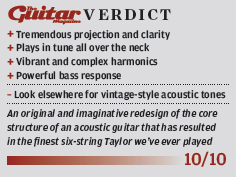Related Tags
Review: Taylor Builder’s Edition K14ce with V-Class bracing
Taylor’s V-Class bracing is a seismic shift in acoustic construction that promises more volume, great tone and improved intonation.
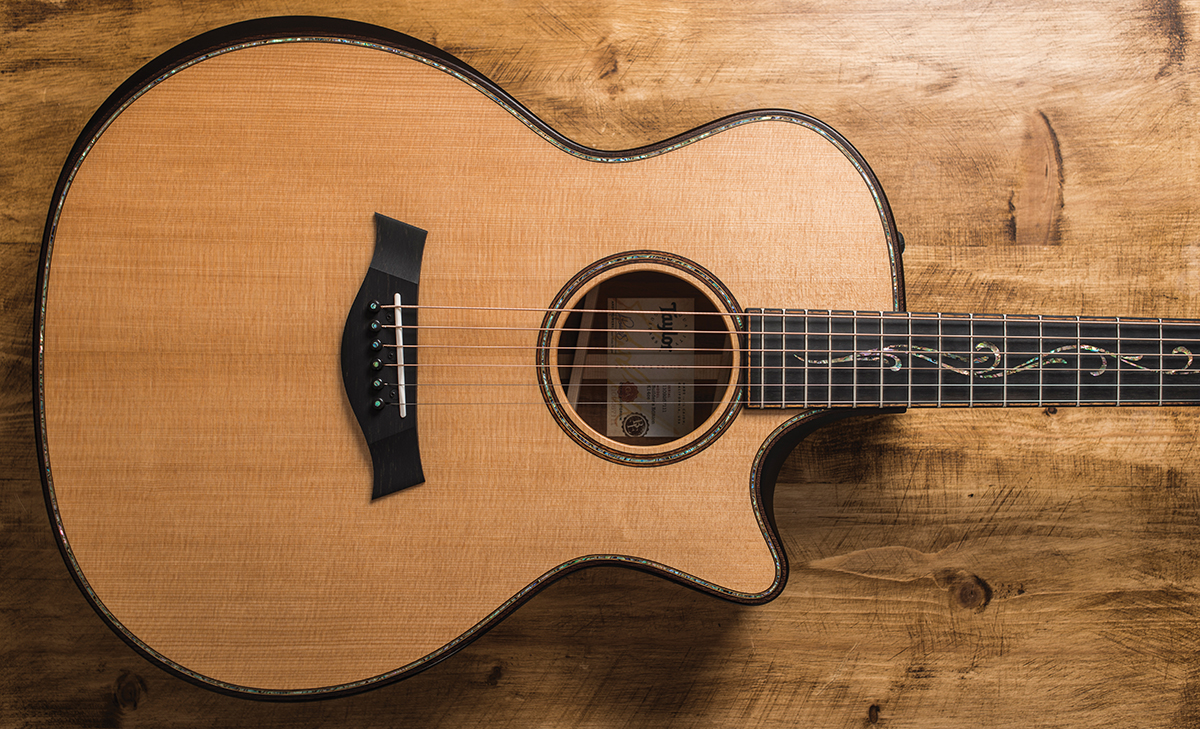
The Taylor Builder’s Edition K14ce
Whether you’re a Taylor Guitars aficionado or not, what follows ought to be of interest to every acoustic player. Rather than a guitar review in the conventional sense, this is in large part a technical appraisal of a potentially revolutionary new concept in acoustic guitar building.
Although the acoustic world has seen far more innovation and experimentation over the last couple of decades than the electric world has managed since the mid-50s, much of it has been confined to small-scale builders. To put this into perspective, Taylor is the world’s largest manufacturer of acoustic guitars.
So for it to introduce an entirely new bracing system – with the avowed intention of gradually phasing it in across a big slice of the company’s product range – represents an audacious gamble, as well as a huge financial commitment.

Although much modified and finessed, CF Martin’s X-brace design has been the industry standard for flat-tops since the late 19th century. What Taylor is proposing is tantamount to a reimagining of the American steel-string acoustic guitar. If it proves as successful and popular as Taylor hopes, the guitar featured here may be seen as historically significant in years to come.
Now, if you’re thinking ‘if it ain’t broke…’, you’d have a fair point. There is nothing intrinsically ‘wrong’ with X-braced acoustics, and most acoustic builders will acknowledge that it’s a superbly effective compromise. A guitar top has to be strong and stiff enough to withstand the considerable pull of a set of strings, yet light and flexible enough to vibrate freely and produce a loud and musically pleasing tone.
If it’s too light and flexible the strings will pull the top apart, but if it’s too rigid, volume and tone will be adversely effected. This means there is an optimal region where the flexibility versus stiffness balance is about right. Yet within that region there are other comprises to consider – specifically the trade-off between volume and sustain.

In a nutshell, a structurally sound top on the ultra-light and flexible end of the spectrum will produce notes with great amplitude but less sustain. Andy Powers offers the banjo as an extreme example, where the top itself very quickly absorbs most of the string’s energy after an initial volume spike. The other end of the spectrum would be a solidbody electric, that sustains far longer but produces very little acoustic volume.
Throughout his guitar-building career, Andy Powers has been on a quest to improve sustain while maintaining or even increasing the volume of his acoustics. Eventually he had to acknowledge that he had reached a “design cul-de-sac” with regard to the X-braces and to progress further, a radical re-think was required.
Rather than try to balance stiffness and flexibility within the confines of an X-brace, Powers came to the realisation that sustain and volume required stillness and movement to coexist within the same structure. Inspiration came from Powers’ other great passion in life – surfing. One morning, Andy was watching the waves coming in and noticed how they split against a stone jetty then continued their movement along each side.

Taking out his notebook, Powers sketched his idea for a new bracing pattern with two braces in a V configuration arranged along the length of the top forming a very stiff ‘jetty’ surrounded by areas of great flexibility.
Understandably, much experimentation was required to optimise Power’s initial design and pictures of the finished result reveal the result to be something deceptively simple, minimalist and undeniably beautiful to behold. A mushroomshaped spruce patch is glued to the top in the bridge area and the two longitudinal V braces are notched so they’re glued to the spruce patch as well as the top. The spruce patch extends well beyond these main braces on both sides, to assist in the transference of vibrations to the top’s more flexible regions.
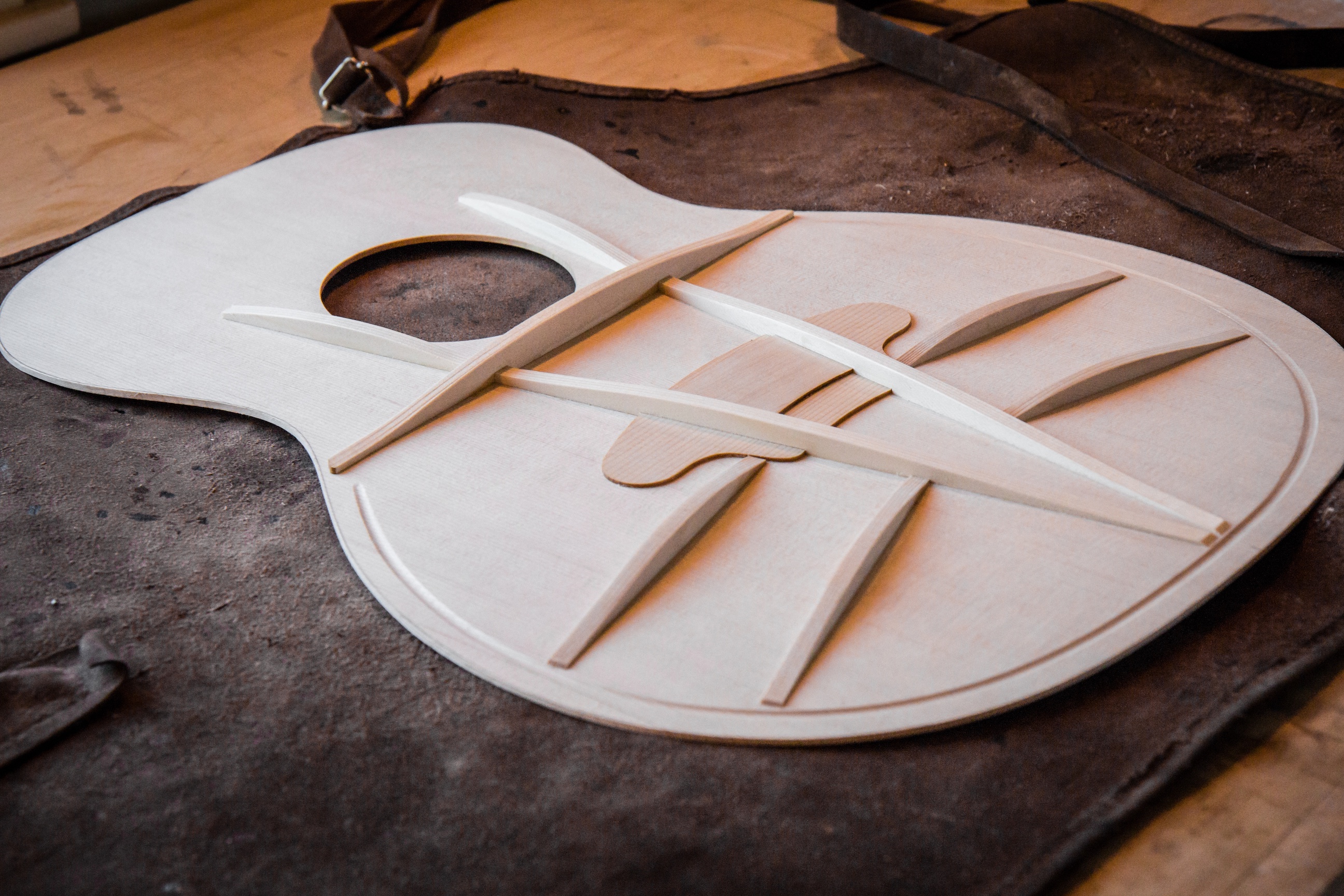
The V braces are almost touching near the tail block then splay outwards to pass a centimetre or so beyond each side of the soundhole. They taper to a high point above the bridge patch then dip under a lateral brace that spans the full body width just below the soundhole. Beyond this brace, the main braces again rise and fall in height to resemble a series of waves.
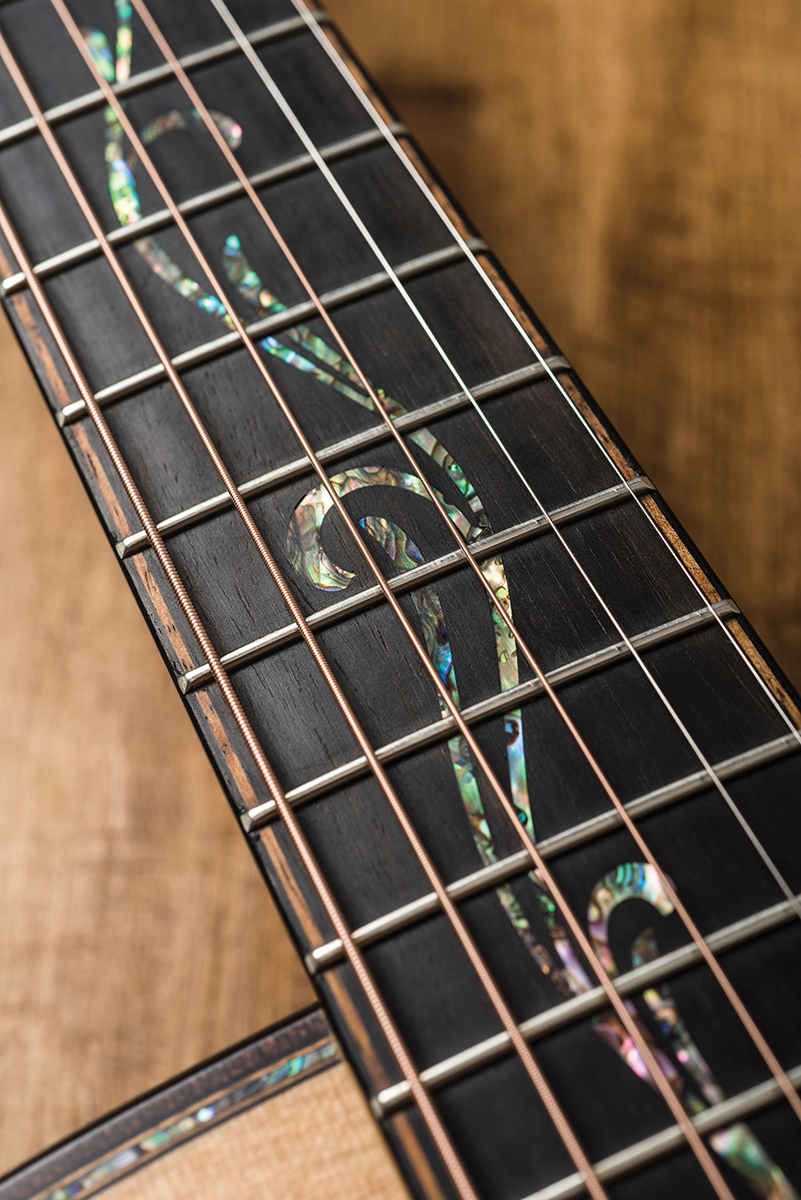
A maple patch is glued over the spruce patch and between the V braces to anchor the ball ends of the strings. A pair of tapered fan braces splay outwards from each V brace and Powers’ earlier innovation of a shallow trough known as a ‘relief rout’ cut into the top around the lower bout area carries over to this V-Class design.
Here in the UK, the ‘Builder’s Edition’ moniker may evoke something a tad proletarian, but this K14ce Grand Auditorium is anything but. A near holographic torrefied spruce top combines with koa back and sides, heavily rolled binding and an ebony fingerboard and bridge. The body finish is described as ‘Silent Satin’ and the back and sides are treated to a Kona Burst.
Abalone appears front and back, with ‘Spring Vine’ inlays along the fingerboard and on the ebony peghead. The neck and headstock are also treated to ebony binding with koa purfling. Packing the latest Expression pickup system and arm and cutaway chamfers, the K14ce feels more like a hand-built custom instrument in the Taylor style than a regular factory Taylor.

The slanted alignment of the back braces is another notable feature of the guitar, which Powers explains. “That’s a concept we introduced with some models within the 800 series a few years ago. Skewing these braces changes the back’s stiffness and therefore relationship with the top. This particular guitar design can be thought of as having two diaphragms like a drum with a top and bottom head. Changing the tension of either of these membranes will change the response of the drum.”
The back brace tips also stop short of the rims. Again, this is intended to promote flexibility and movement of the back and differs from the traditional practice of tucking the brace ends into the kerfing.
Although Powers’ was primarily focused on tone, volume and sustain, vastly improved intonation emerged as an exciting and somewhat unexpected byproduct of V-Class bracing. This prompted further refinement of V-Class bracing as Powers’ understanding of how bracing patterns effect intonation developed.
Since it’s intended for players rather than guitar builders, Taylor’s explanation of how it all works is more like a series of extended analogies. However, Andy Powers kindly provides TGM with a solid technical overview that you can read here. In the meantime, here’s our simplified version based on discussions with the man himself.

The V braces and bridge form the ‘immovable jetty’ and energy from the strings equates to the waves crashing against it. The jetty/bridge is an area of stillness that, rather than absorbing string energy, effectively distributes it outwards to carefully tuned flexible regions of the top that vibrate in response to produce sound.
Since energy isn’t wasted by moving the bridge and areas of the top that don’t generate sound, the energy lasts longer and is used more efficiently. Hence the improved volume and increased sustain.
Regarding how in-tune the guitar sounds, the improvement is attributed to the way that the V-Class top vibrates. With X-bracing some areas vibrate freely, others less so, and direction of movement can be completely random.
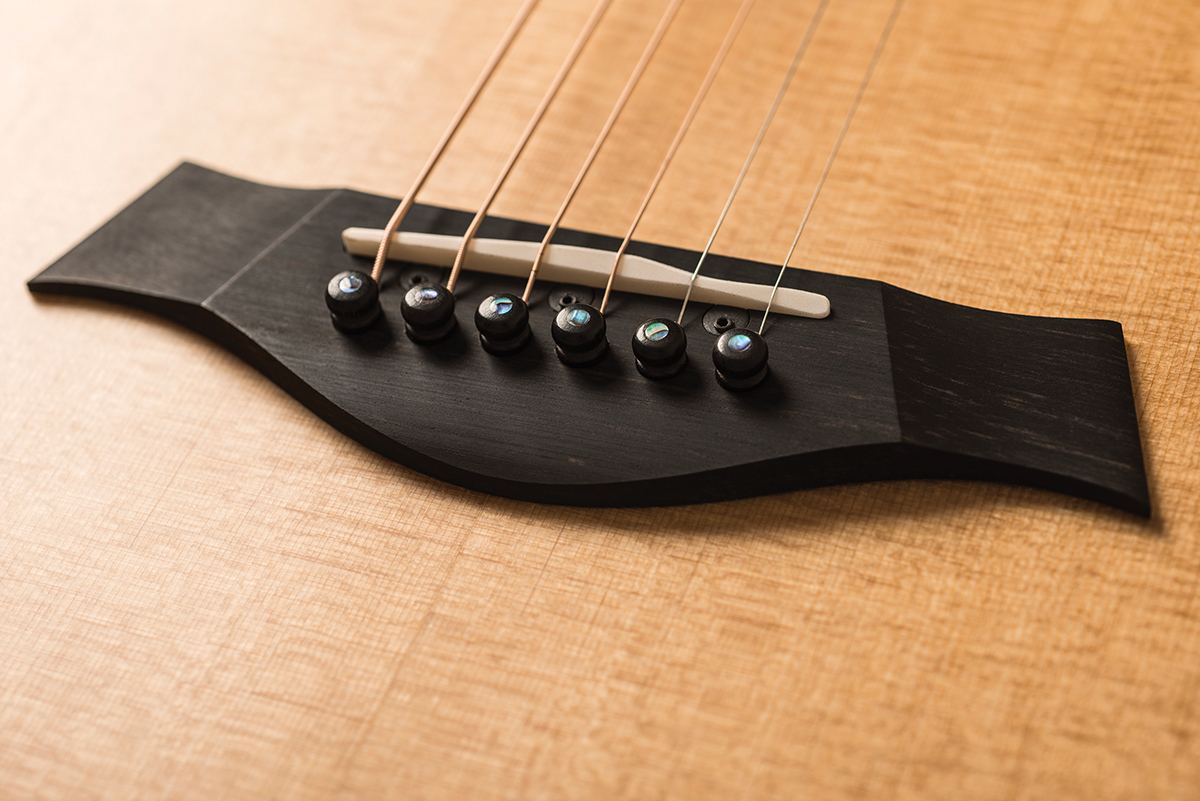
Additionally, the top’s surface can deform while in motion. As a consequence, not all regions of the top are physically able to vibrate at precisely the same frequency as the energy source – namely the strings. This discrepancy accounts for the tuning difficulties common to acoustic guitars that cannot be remedied using the usual method of saddle compensation. A useful analogy might be cone cry from an electric guitar speaker.
However, V-Class bracing allows the top to vibrate in a more orderly manner like a speaker cone in terms of uniform direction of movement and absence of deformation in the shape of the vibrating surface. This ensures a very close correlation between the frequency content of the energy source and the frequencies reproduced by the top.
Powers confirms, “It was exclusively the bracing. It shows me that equal temperament for guitars was better than I thought.” Let’s see how all this stacks up…
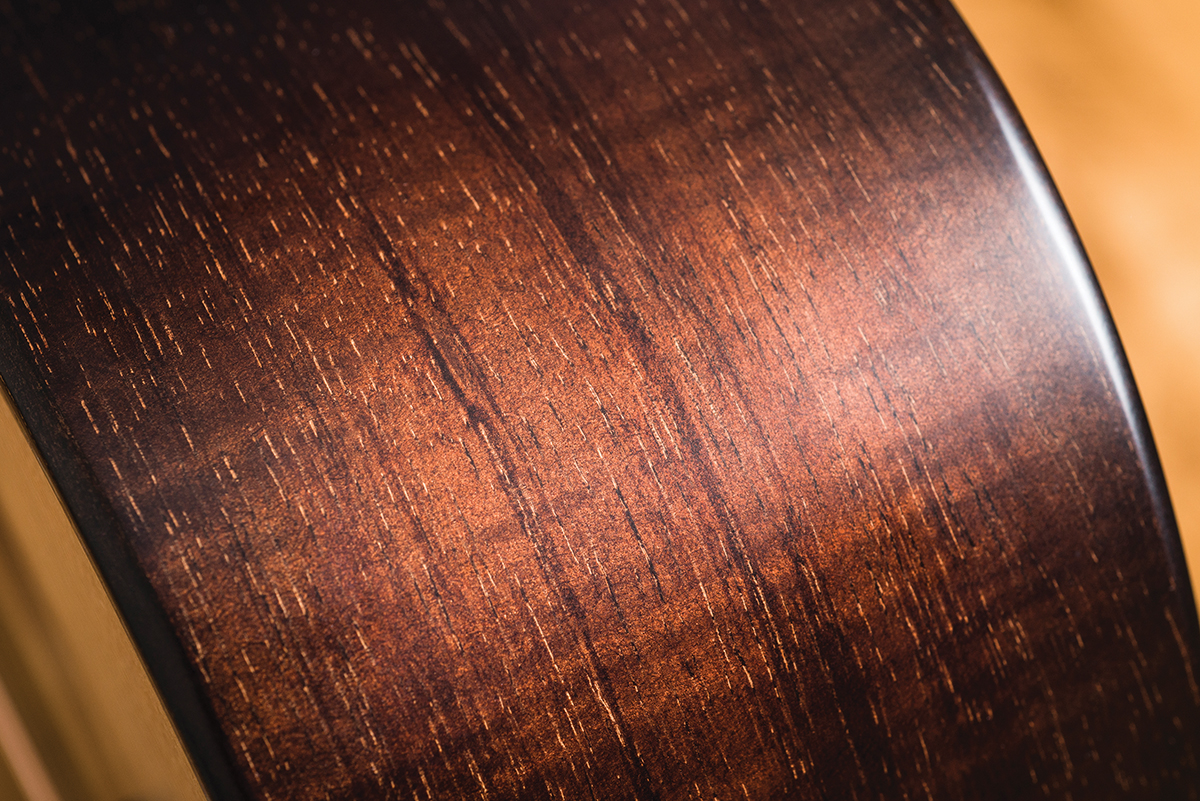 In use
In use
Despite Taylor’s radical redesign, the K14ce still sounds like a flat-top and the braces certainly don’t make it sound more like an archtop or a baritone mandolin. What we have is a bright but sweet, full, deep and extremely loud acoustic guitar. No doubt the torrefied top helps, but this guitar already has a very freed up and willing response.
Curious about how the top is behaving, we tune to open D, place the guitar on a cushioned surface to dampen the back and strum a chord. By placing a hand on the top and lifting off, we quickly identify the lively parts. The K14ce vibrates freely in the areas beyond the bridge ends. The damping effect is so strong on the treble side that it can be compared to lifting a mute on and off a trumpet.
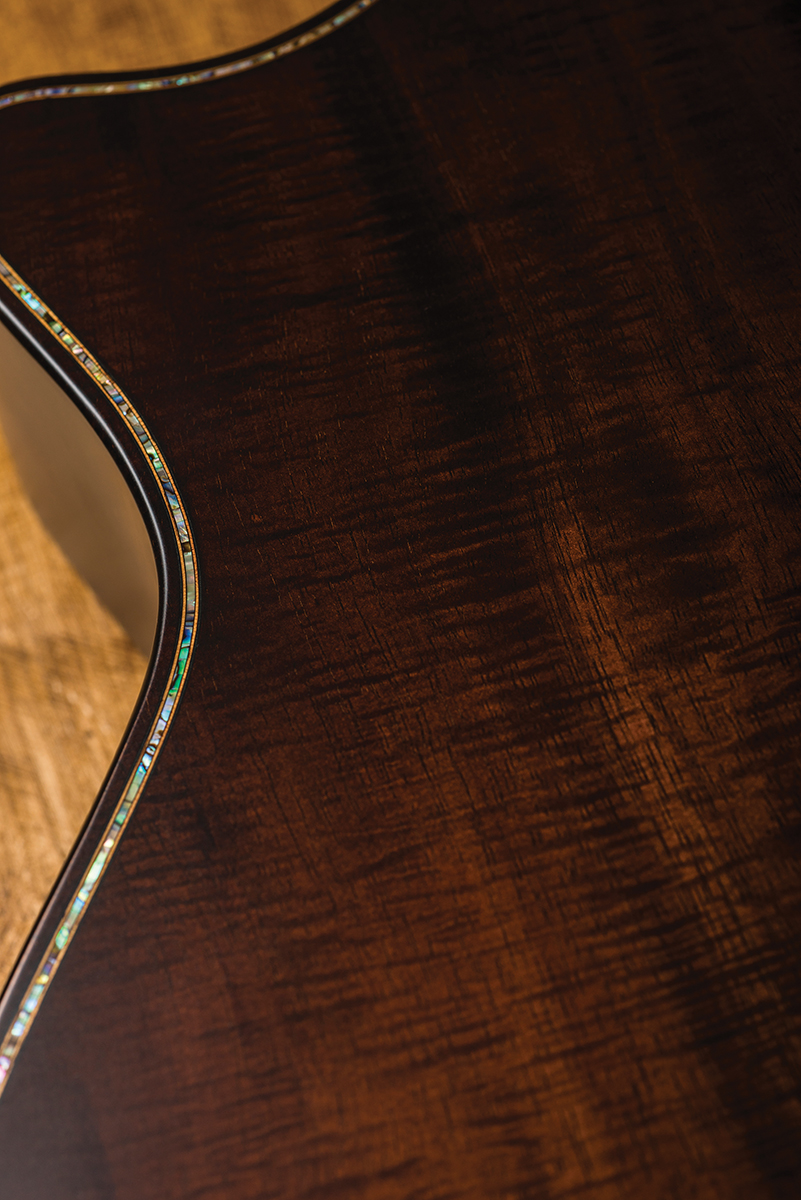
Nothing much occurs around the cutaway, but there is some vibration on the bass side of the upper bout. Perhaps most significantly, there is little audible effect when we damp the area behind the bridge. Conducting the same test with an X-braced acoustic demonstrates that the vibrating areas are more dispersed and far more of it happens directly behind the bridge. It’s clear that the way V-Class bracing operates is very different.
Bass extension impresses because the K14ce has genuine low-end power that’s delivered with a punch rather than a boom. Trebles are clear and airy with sparkling complex harmonics and the fine string to string balance makes for easy picking. For these characteristics alone, we could describe the K14ce as an exceptionally good-sounding Taylor acoustic with a fast percussive response, and a bright, vibrant and modern tone. But there’s more to explore here.
The dramatically improved sustain manifests in various ways – the most obvious being the fact that you can play a single note or a chord and both last significantly longer than you would expect from a regular flat-top. However, what happens during the slow note decay is the really interesting bit.

Harmonics linger on inside the body like it’s an analogue reverb chamber, and you can hear them continuously swell and shift. This harmonic overhang is a surprisingly rare phenomenon and we most closely associate it with vintage ladder-braced acoustics.
Once you get attuned to it, the effect is mesmerising. Try tuning to an open chord, hit the low string and let it ring then start soloing on the high strings. The low string provides a key tone while the open strings provide sympathetic resonance and it’s heady stuff.
As for the intonation, the reality lives up to all the promises. We often find acoustic cutaways utterly pointless when most everything you try and play above the 12th fret sounds out of tune. With the K14ce you can imagine you have a capo on the 12th fret and play regular open chords an octave higher than usual. The octave chords chime with the open strings without any tuning sourness. All the high-up stuff you might only consider playing on an electric, is fair game on the K14ce, too.

You can see it with a strobe tuner, because even on the fast setting, notes remain rock solid rather than waver between a few cents sharp and flat. But more importantly, you can tune up with open strings confident that an open E, D and G major will all sound equally in tune.
This will be a godsend when recording, where microphones cruelly expose tuning discrepancies. The K14ce is also suited to studio work because the treble sheen and clarity that invariably have to be dialled in with an equaliser is inherent to the guitar. However, compression will be required because the dynamic range is absolutely huge.
We have become well acquainted with Taylor’s Expression II pickup system, so we are not going to dwell on it here. This may be the finest we have heard it sound because what we are getting through our studio speakers is very close to the K14ce’s natural sound. String balance is excellent and there’s not even a hint of the phasiness we’ve sometimes detected.
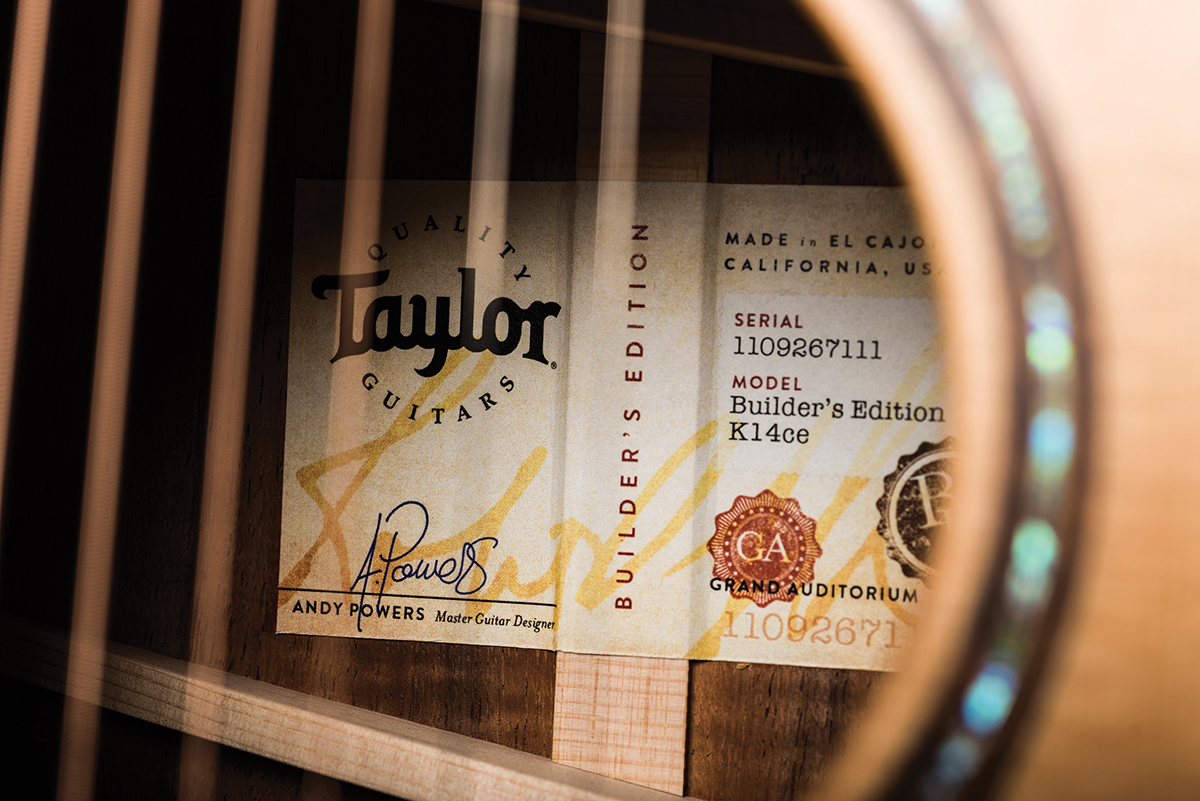
There is a genuine sense of excitement at Taylor about the V-Class bracing system and we think it’s well justified. The sonic charms and in-tuneness are undeniable and the result is a fabulously enjoyable musical experience.
The science
Andy Powers explains how it all works. Brace yourself…
“An X-braced guitar top is not particularly strong, nor flexible in any direction,” Powers notes. “It’s meant to strike a balance. In doing this, it creates lots of stiffer and less stiff spots (the nodes and antinodes makers talk about). Those spots tend to correspond with resonance at specific frequencies. The actual frequency values can shift due to the effects of moisture in the air, barometric pressure and a bunch of other uncontrollable factors.
“All of these frequencies are, to some degree, set in motion as a bridge rocks in every direction; side to side, tail to headstock, up and down… as if the bridge were on a Bosu balance ball. As it tries to vibrate, the whole top is going along for the ride and moving all over the place. The V-Class design reduces the tail-to-neck motion so it’s more like an electric guitar, and that’s where the sustain comes from.
“The string energy is redirected sideways into deliberately flexible areas of a top in order to produce volume. These flexible areas are not merely flexible, since that would allow the same chaotic resonance-cancelling motion an X-braced top would but over a smaller area. They are designated flexing areas, which have a controlled geometry, and this makes them work more like speaker cones.
“So, you could say these areas are producing volume less by type of motion or changing surface shape, and more by time of motion. The time of motion can be summed together just like any other multiple frequency wave source producing a unique waveform. Because the top is capable of moving in any form of time oscillation, without significantly deforming its surface shape, the unwanted inharmonic resonance is reduced and the guitar sounds more in tune.
“The word intonation is directly translatable to ‘in tune-ness’ or the degree of pitch accuracy. In the guitar word, we tend to equate the word with the word compensation, which refers only to the accommodation for string stretching which occurs when a note is depressed.
“In other words, within the guitar world, we tend to write an equation that looks like ‘intonation = compensation’. In reality, this equation is incomplete. The equation should look something more like ‘intonation = compensation x harmony’. This second value, harmony, speaks to the pitch accuracy of the notes, which is influenced by the amplifying effect of the guitar.”
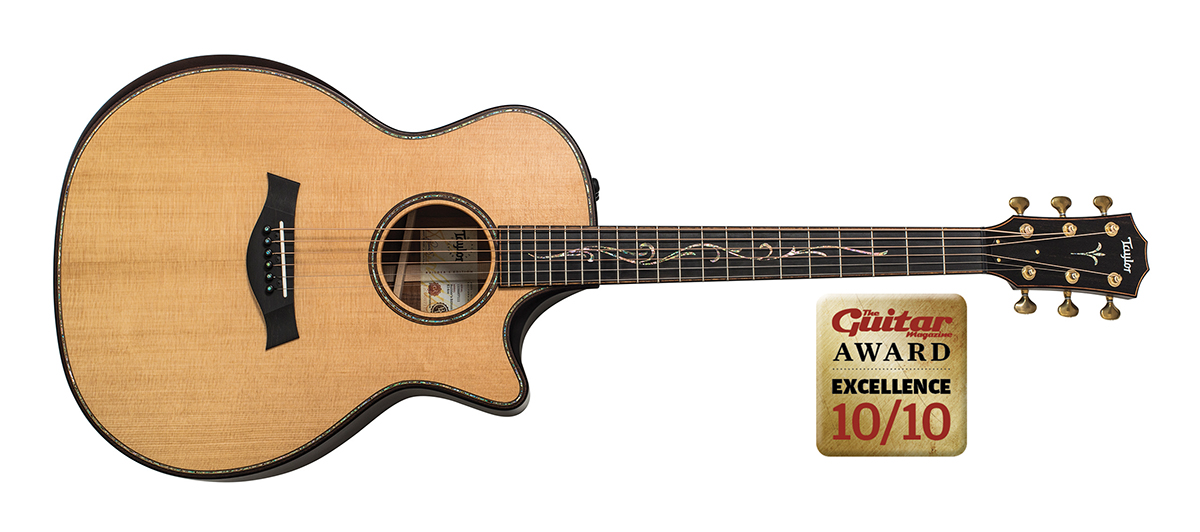
Key Features
- DESCRIPTION All-solid electro-acoustic 6-string guitar. Made in the USA
- PRICE £5,759 (inc hard case)
- BUILD Torrefied Sitka spruce top with koa back and sides, neo-tropical mahogany neck, West African ebony bridge, fingerboard and peghead overlay, 14th fret neck join, Gotoh 510 tuners, black graphite nut and Micarta saddle, paua/koa body edge treatment, ebony bridge pins with abalone dots, bevelled armrest and cutaway
- ELECTRICS Taylor Expression II system
- SCALE LENGTH 647.7mm/25.5”
- NECK WIDTH 44.7mm at nut, 54.6mm at 12th fret
- NECK DEPTH 20mm at first fret, 21mm at 9th fret
- STRING SPACING 37.91mm at nut, 55.25mm at bridge
- WEIGHT 4.58lbs/2.08kg
- LEFT-HANDERS No extra charge
- FINISH Silent Satin over Kona Burst back and sides
- CONTACT Big Fish Studios 01206 382224 www.taylorguitars.com
